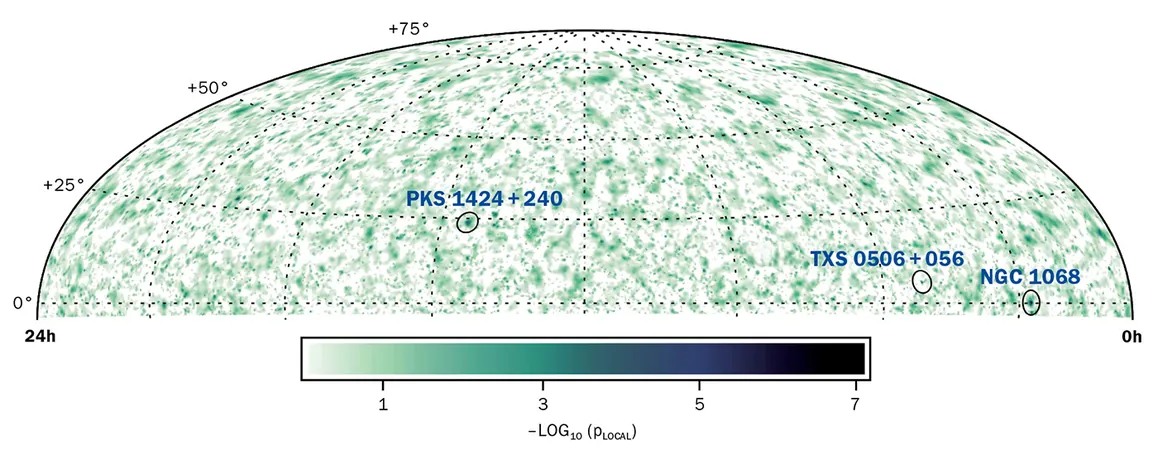
Unveiling the Neutrino Universe: The Next Era of Astrophysics
2025-05-19
Author: Sarah
Exploring the Neutrino Frontier
In the next 20 years, neutrino astrophysics is set to soar, unraveling the universe's most enigmatic secrets. Lu Lu anticipates groundbreaking advancements in detector technology, capable of measuring energies ranging from 1 exaelectronvolt (EeV) to an astonishing 1 zettaelectronvolt (ZeV).
Nature's Mighty Accelerators
Picture this: the cosmic playground includes the vast Lake Baikal, the Mediterranean Sea's depths, and the South Pole's pristine ice—all will serve as tracking stations for these elusive particles. Unlike traditional particle experiments, neutrinos can reveal energies that far exceed those typically achievable. The universe has natural accelerators, such as the monumental supermassive black hole jets in Messier 87, which stretch for about 5000 light years, offering a glimpse into processes beyond our current understanding.
High-Energy Neutrinos: A New Era in Astronomy
High-energy neutrinos are revolutionizing astronomy. They offer insights into cosmic events that are otherwise obscured by gas and dust. For instance, NGC 1068 was the first steady neutrino emitter identified. Neutrinos, unlike charged cosmic rays, travel in straight lines, unaffected by magnetic fields, allowing them to maintain their direction and provide a clearer picture of their origins.
Astrophysical questions abound: Are there undiscovered particles beyond the Standard Model at these extreme energies? What mechanisms propel them to such heights? The groundbreaking detection of a neutrino with an energy exceeding 220 PeV has opened the door to ultra-high-energy neutrino astronomy, heralding a new generation of expansive detectors.
The Challenge of Detection
Detecting these high-energy neutrinos poses a fierce challenge. The cosmic neutrino flux diminishes exponentially, requiring detectors on a cubic-kilometre scale to catch neutrinos beyond 100 TeV. As energy increases and approaches the PeV scale, the likelihood of absorption by Earth rises dramatically.
The journey began in the 1980s with the DUMAND project, aiming to harness underwater sensors to detect these elusive particles. Although it faced engineering challenges and was ultimately cancelled, lessons were learned, paving the way for next-gen projects like IceCube, KM3NeT, and Baikal-GVD, all seeking to catch neutrinos in unique environments.
Innovations on the Horizon
Ten years of data from IceCube have led to remarkable discoveries, including the first neutrino observations from our Milky Way, and the detection of neutrino emissions from supermassive black holes. Upcoming facilities like the Pacific Ocean Neutrino Experiment (P-ONE) and others will expand our observational capabilities significantly.
Rethinking Detection Strategies
As researchers push for exascale capabilities, there's a pivotal need for innovation. Current optical detection methods may not suffice for the ultra-high energy scale. Some experiments propose using Earth's atmosphere as a calorimeter, allowing for a broader, more sensible array of detection instruments.
The Pierre Auger Observatory illustrates this by sampling vast areas of the atmosphere for charged particle cascades from high-energy cosmic rays. By refining how we identify tau neutrinos, researchers aim to improve the detection of these rare emissions.
Going Beyond Earth
Ambitious plans are in place for extraterrestrial observations. Projects like POEMMA will utilize satellites to scan Earth's atmosphere for signs of air showers from neutrinos, while GRAND plans to employ vast arrays of antennas spread over remote, mountainous terrains to catch radio signals from these cosmic events.
The Search for Cosmic Truths
Groundbreaking experiments are set to leverage the Moon as a target. When ultra-high-energy neutrinos collide with the Moon's surface, they could ignite detectable particle cascades back on Earth through coherent Askaryan radiation.
Building a Global Neutrino Network
Global cooperation will be essential for comprehensive monitoring of the universe. By collaborating on diverse neutrino observatories, scientists can ensure real-time tracking of transient astrophysical events across the globe, which will be crucial in multi-messenger astronomy, synergizing observations with gravitational wave findings.
This collaborative effort marks an exciting future for neutrino research, promising to unveil some of the universe's most tantalizing secrets and transform our understanding of fundamental physics.


 Brasil (PT)
Brasil (PT)
 Canada (EN)
Canada (EN)
 Chile (ES)
Chile (ES)
 Česko (CS)
Česko (CS)
 대한민국 (KO)
대한민국 (KO)
 España (ES)
España (ES)
 France (FR)
France (FR)
 Hong Kong (EN)
Hong Kong (EN)
 Italia (IT)
Italia (IT)
 日本 (JA)
日本 (JA)
 Magyarország (HU)
Magyarország (HU)
 Norge (NO)
Norge (NO)
 Polska (PL)
Polska (PL)
 Schweiz (DE)
Schweiz (DE)
 Singapore (EN)
Singapore (EN)
 Sverige (SV)
Sverige (SV)
 Suomi (FI)
Suomi (FI)
 Türkiye (TR)
Türkiye (TR)
 الإمارات العربية المتحدة (AR)
الإمارات العربية المتحدة (AR)